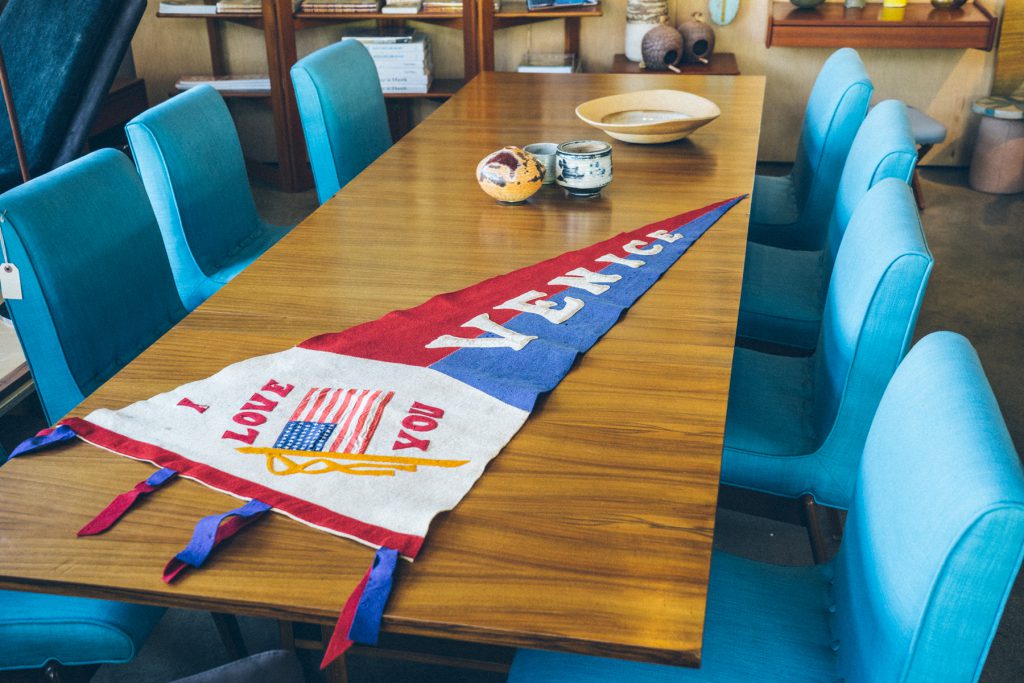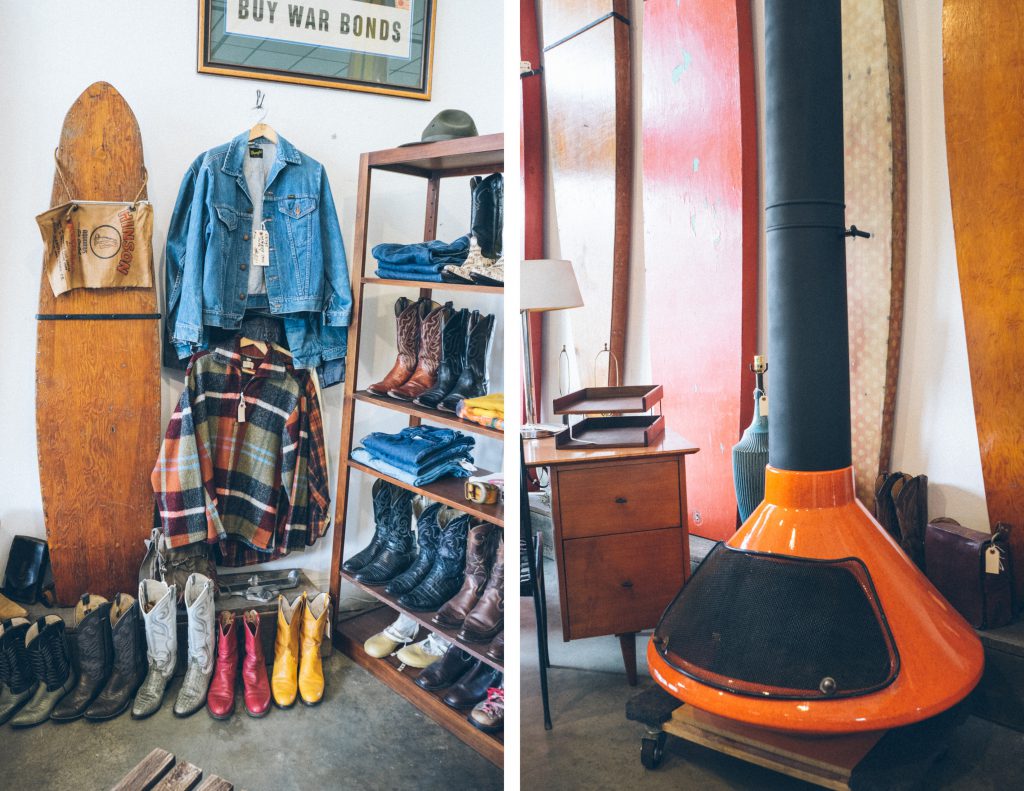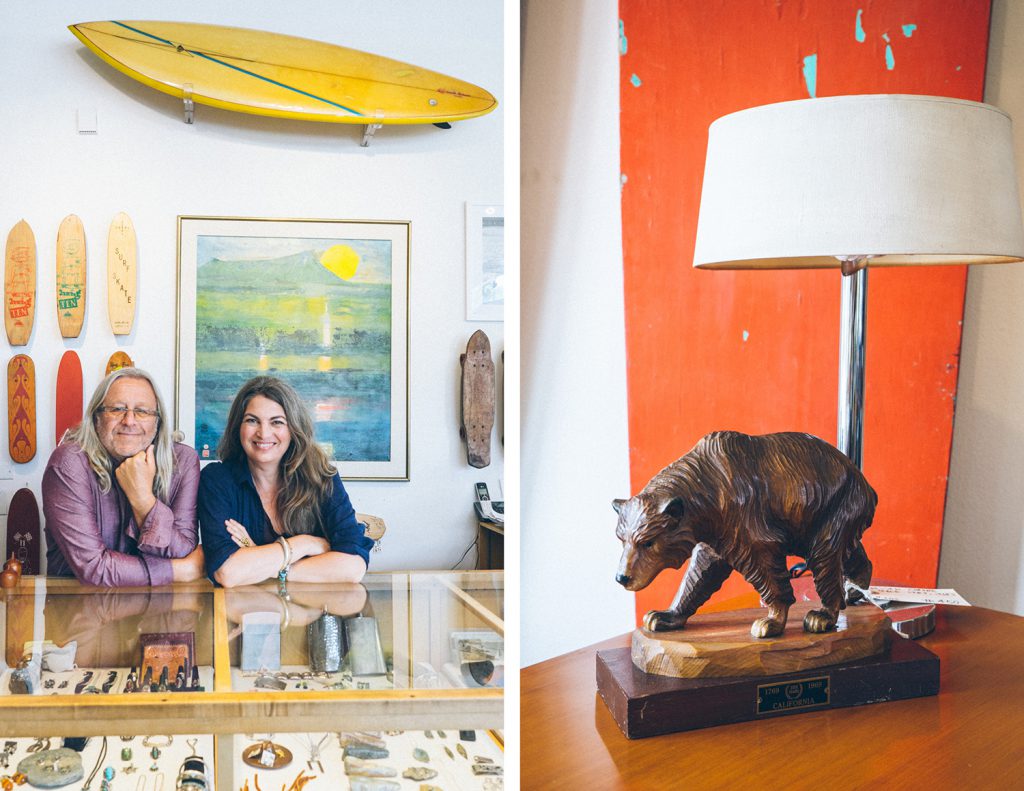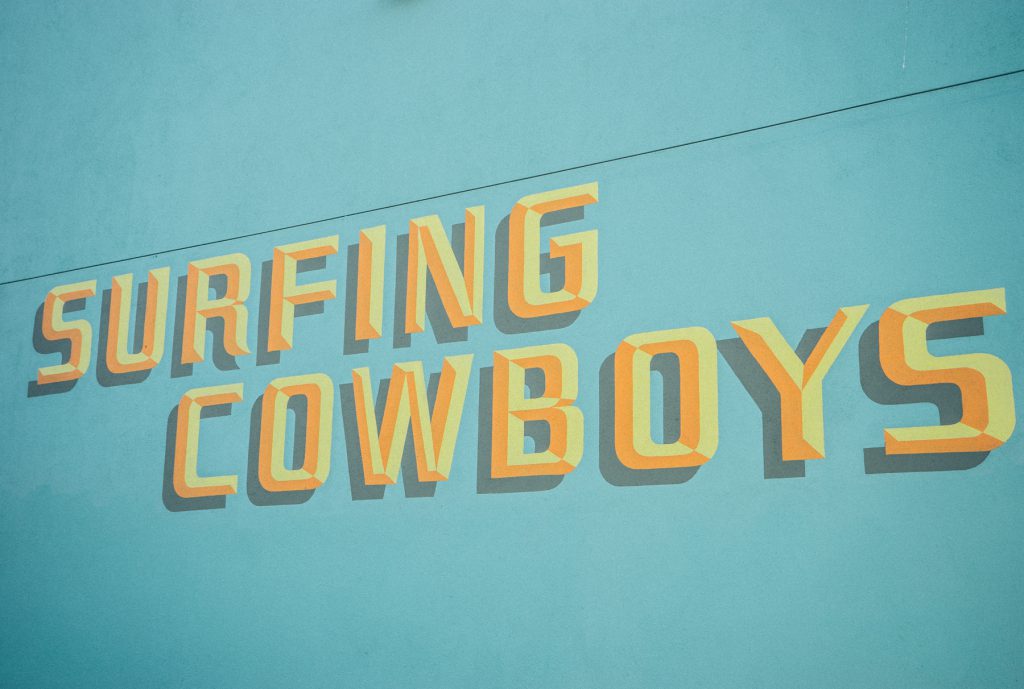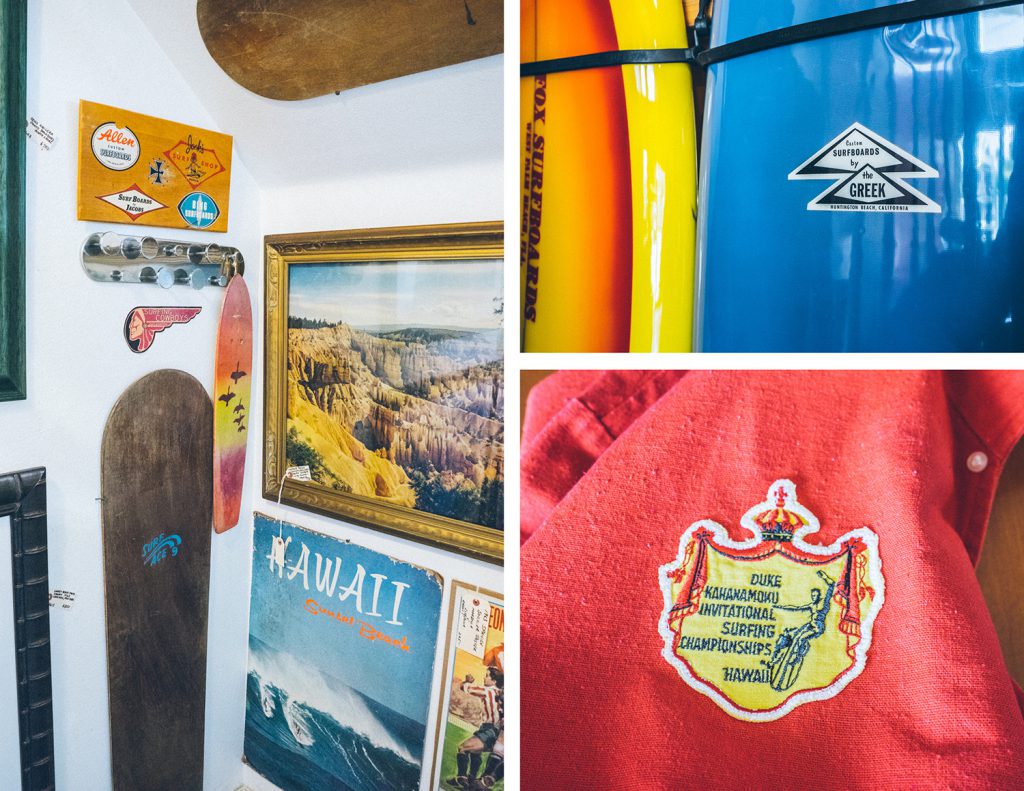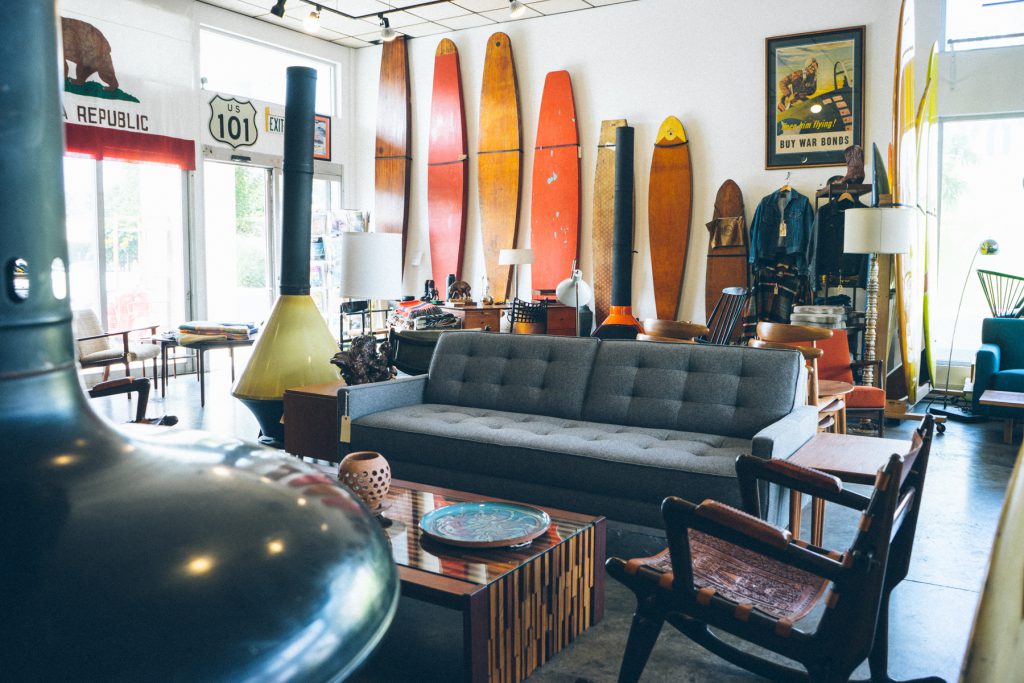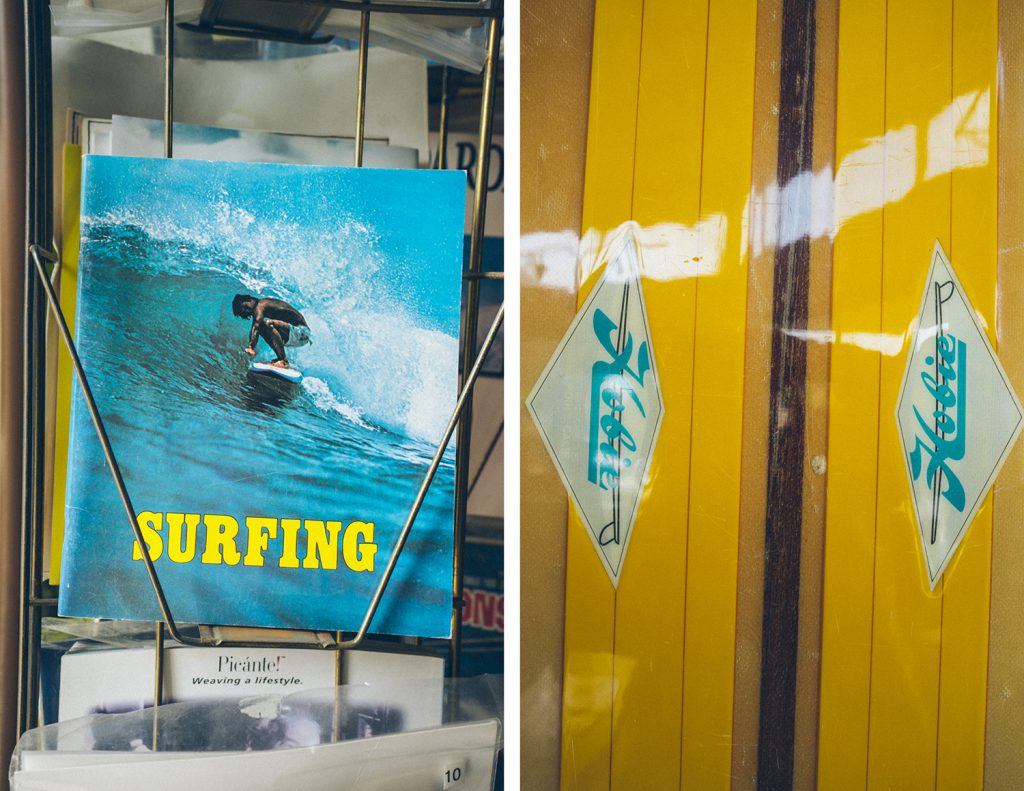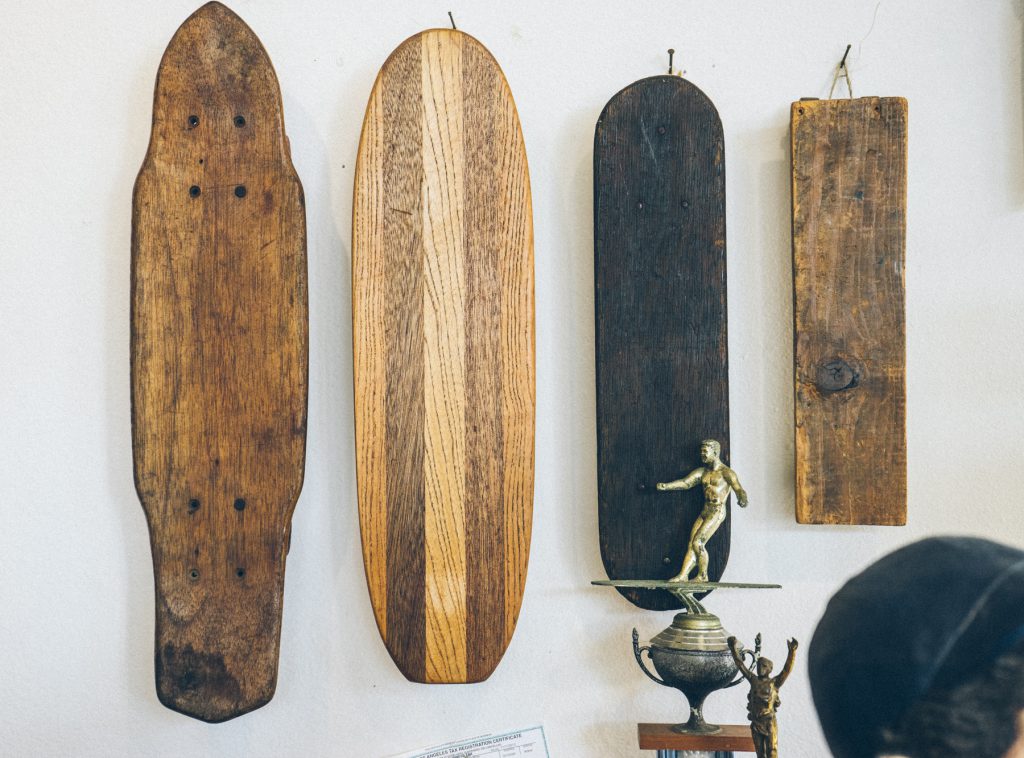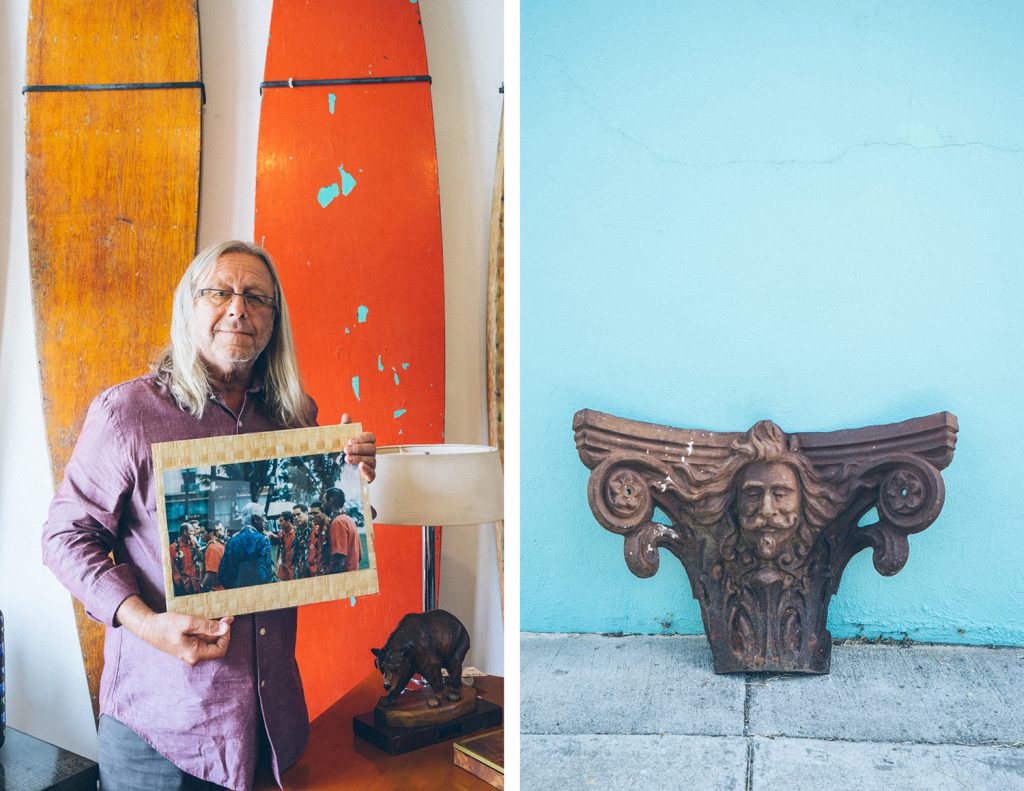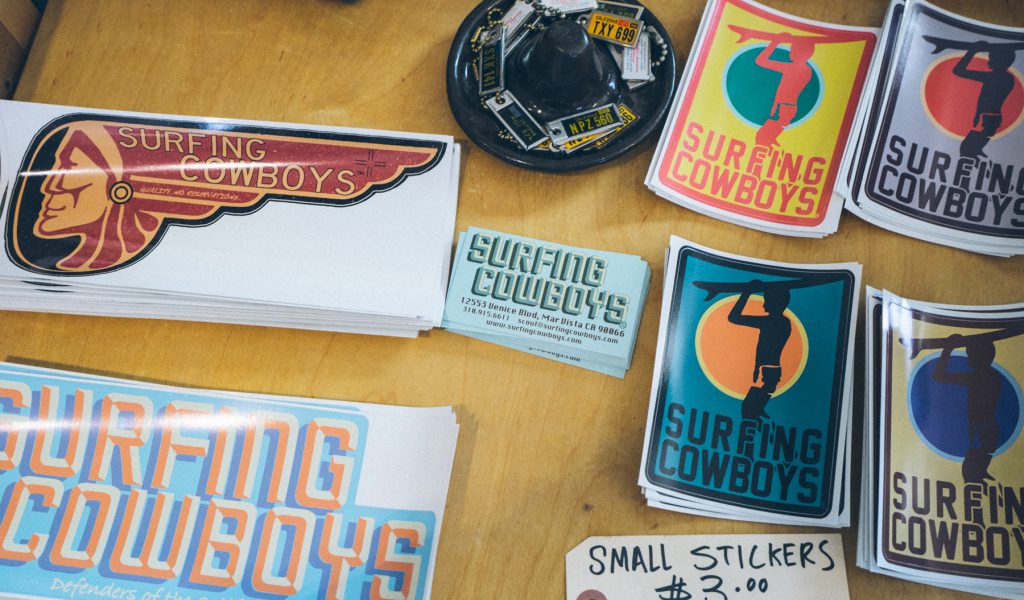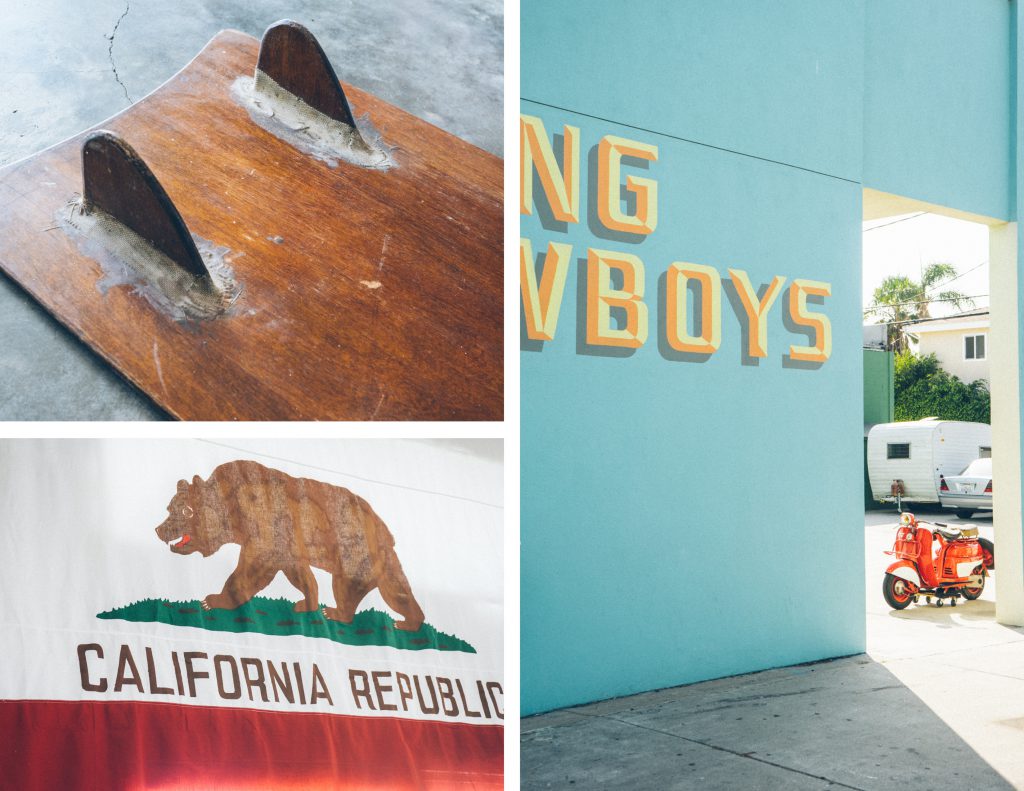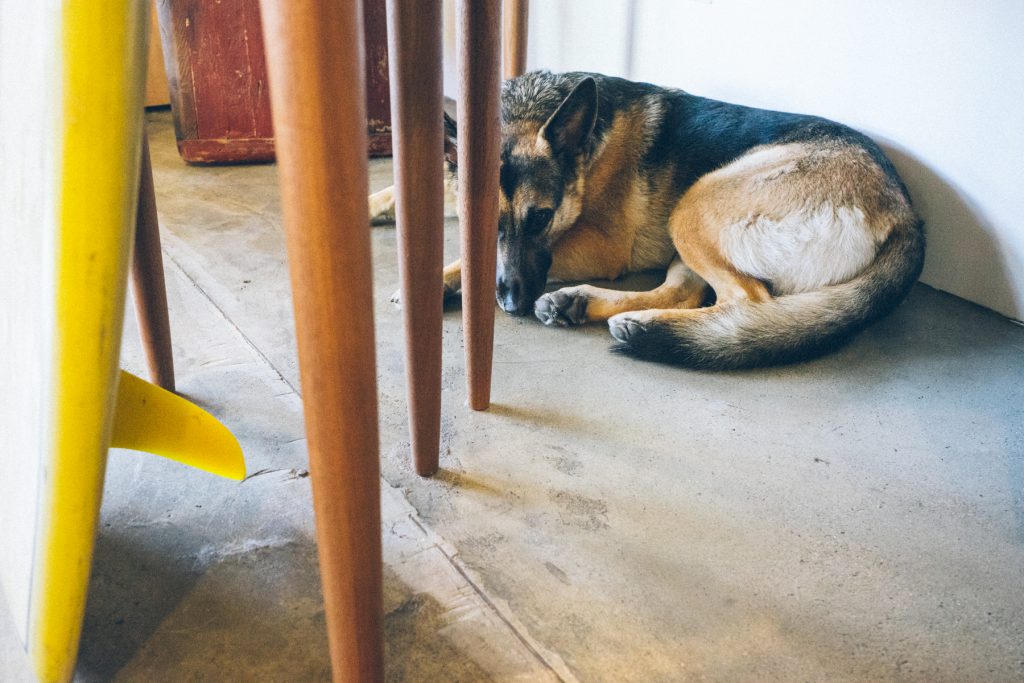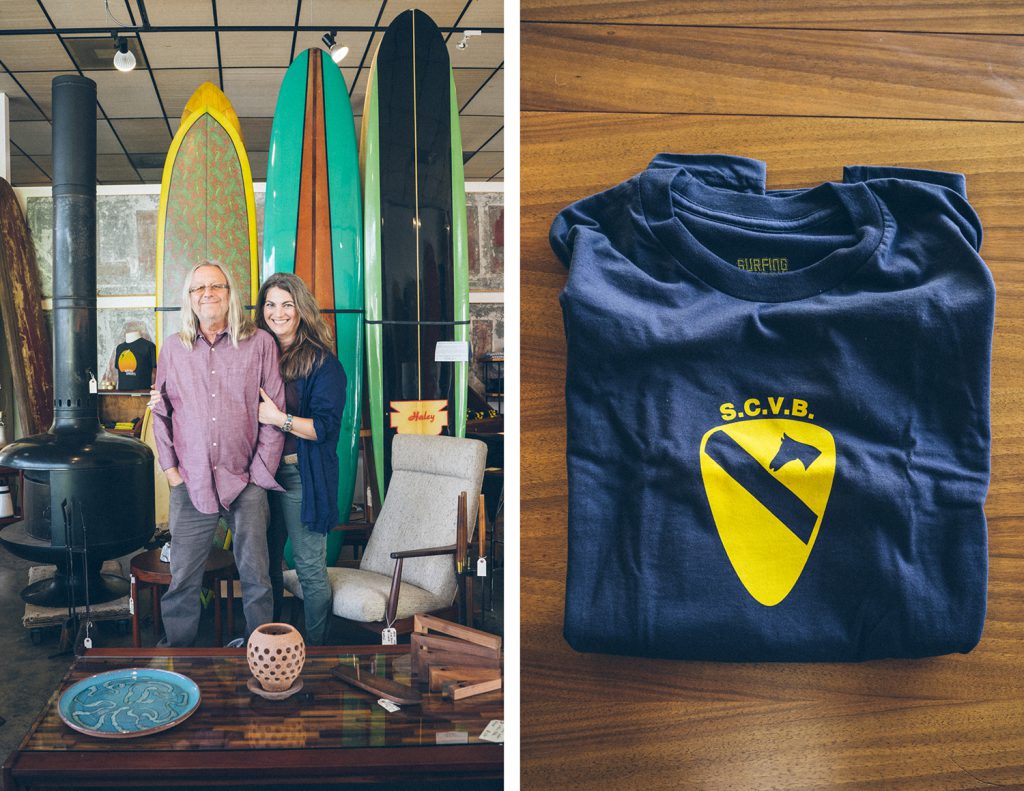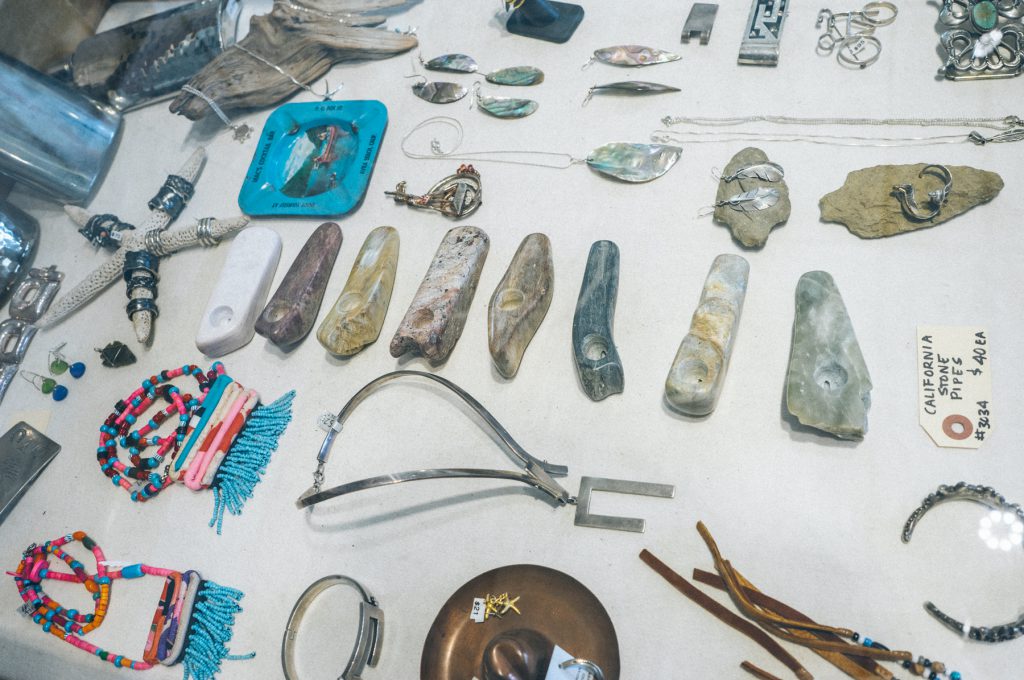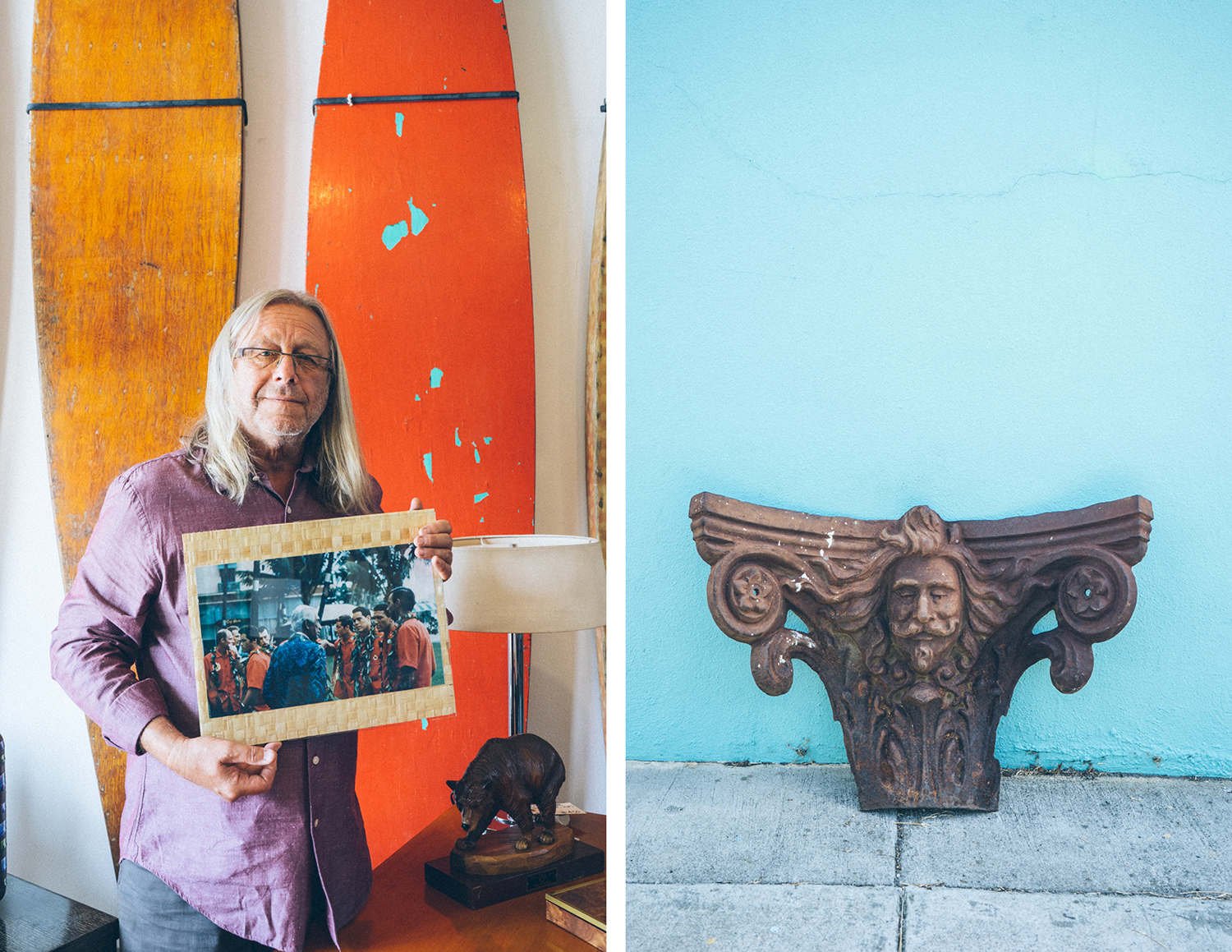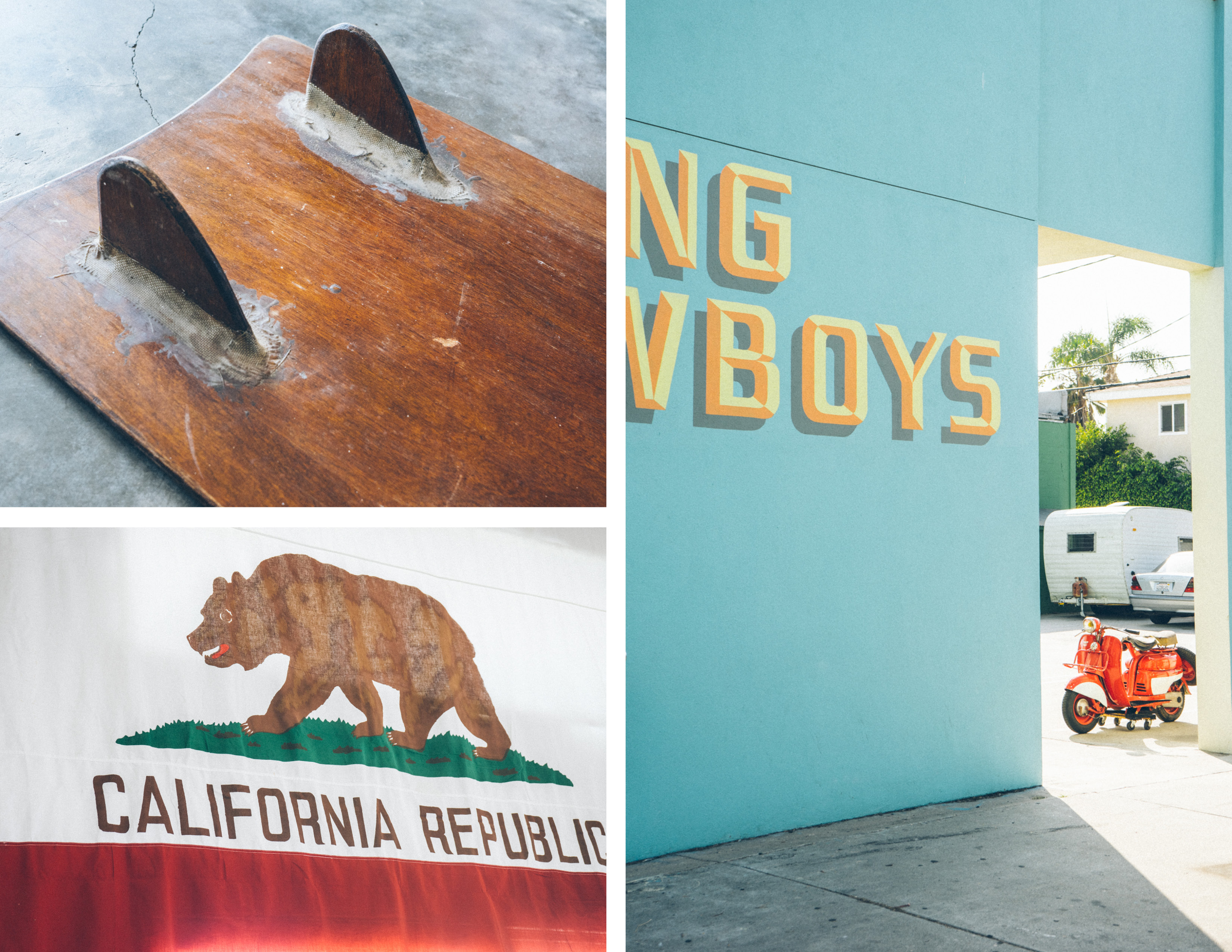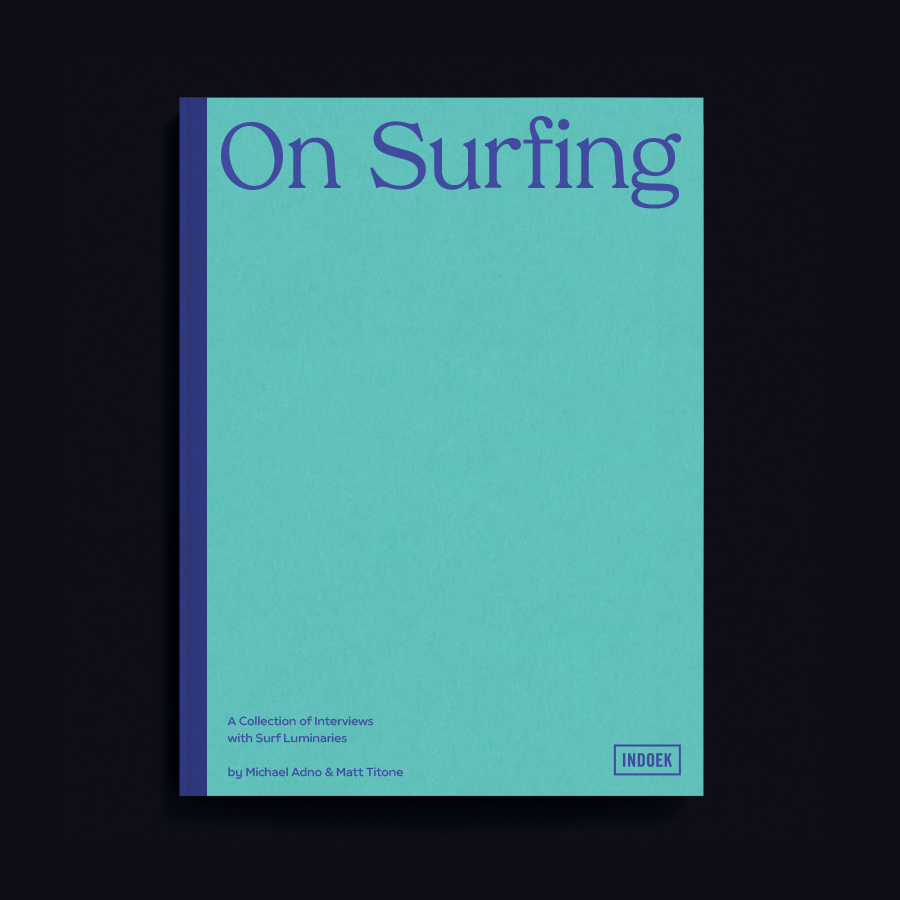What are some of your favorite stories behind some of the
pieces here?
W: There are a lot of great stories. It’s not like one story jumps out. The beauty of these boards and this furniture is partially in the lives that they’ve lived. If they could talk, imagine the stories they’d tell. We have a collector story, but each one these pieces has another kind of story. I look at a paddle board like the Skipper there and I see a father making that for his son or his daughter back in the 1930s. I can see him with his Popular Mechanics magazine, his Tom Blake pattern centerfold open. I see him working the construction out in his garage, then painting it and writing skipper on the top, turning to his kid and saying, “Here we go, let’s go surfing – it’s just like your old man’s!”. That and that kind of stuff is wonderful to me. That’s folk art.
D: I look around and see loads of individual objects that we could talk about, but I’m most excited I think by overall, collective inspirations and juxtapositions. I look at the history of surf captured within these walls. Same thing with the ceramic. All this ceramic was made in ‘60s California at a time when people stopped wearing gold and silver jewelry and started wearing brass. At this same time artists were taking clay and rather then shaping traditionally defined beautiful things, they were making natural, rustic, earthy pieces – they were breaking rules and coming up with new forms. There are rules of design that have been broken all over this shop – both in the objects and their placement next to each other – those are the stories I see that excite me the most.
W: We have a surf aspect to what we do, but pretty much everything here has a story. Look at the Navajo jewelry. The Navajos were always trying to work out what the white man wanted, what interested him, what they would buy. They would make rugs that had cattle on them and trains and trucks – evidently things that the white man placed importance on. In the 1930s a guy called Fred Harvey laid railroad lines across the west and set up trading posts along them, he encouraged local Navajos to create merchandise for the travelers from the East. They put arrowheads, birds, eagles, stuff like that on the jewelry – offering the travelers an opportunity to buy a piece of the romance, the myth, to this day these are referred to as Fred Harvey pieces.
D: On that note we’ve always been a bit of a road stop ourselves. This whole business was influenced from our time on the road. When we moved into that space on Abbot Kinney I hired an old-school sign painter and said I want it to look like a road stop in New Mexico, but cooler – we’re near the coast – we’re selling California. We were a road stop to our personal aesthetic. On the side of the building it said, “Purveyors of Beach Culture and California Lifestyle: Hawaiiana, Mid-Century Modern, Rare Cultural Icons and Cool Euro.” That was back in 1993 or something. That’s what we always were and that’s what we still are, we’ve evolved to a museum-like level, and the range of merchandise has shifted but everything here is for sale and there’s a take away, so that everyone can leave with something.
W: I think the name, “Surfing Cowboys” also conjures up kinder gentler times in a place not so long ago that was desert and ranches. I love the mind’s eye view of seeing guys get in the backs of their old pick up trucks in the 1930s with a giant redwood balsa board that they bought at the pacific system homes or they made themselves and taking it down to Rincon. In those days these guys knew each other because there was maybe 100 of them surfing back in the ‘20s and ‘30s, and in the ‘40s maybe 400 in the whole of California. So a lot of them knew each other personally. They’d go on amazing trips and do amazing stuff.
For me your shop on Abbot Kinney was such an iconic location that I associated with Venice. How did the move to Mar Vista
come about?
W: Wallpaper magazine called us the best store on Abbot Kinney a while back. They talked about the whole designer mix in the Beverly area, and they said there was “a way out west rival on Abbot Kinney… best is Surfing Cowboys.” For us this was huge. We’ve always respected Wallpaper Magazine. Details called us the “Best men’s store in LA.”. So we got hit with three titles, none of them that we really wanted because we didn’t want to be known as just a mens store, but it was kind of fascinating. Getting back to Abbot Kinney it was this old outpost that people would just drive through with the windows definitely up and the doors locked on a short cut to Santa Monica. As a few shops started opening up, people saw that there was four-hour parking on the street and would brave it to Hal’s, perhaps walk a block or two or drive because we were open or Capri was open – Jonny B. Wood was open or one of the four or five other shops that dotted the street; and then it started to fill in.
For a period of time, maybe five years, Abbot Kinney was a magical street with like-minded people that still didn’t get as much traffic as Melrose, Robertson or Montana. We were all really aware that we were in an amazing place and time. And then the NY Times wrote about it, the LA Times wrote about it, and before we knew it there were realtors and developers sniffing around. Wabi Sabi opened and brought valet parking to the street. That to me was the beginning of the end. Wabi Sabi killed it. Gjelina came in and put another knife in its back. Then before we knew it everywhere had valet parking, the food trucks showed up. It just became an impossible street where the masses could get drunk and eat bad food.
D: I think that the earlier, slightly rougher time worked because there was a sense of camaraderie. We were all in it together.
W: We were trying to make it safe without making it trendy. We were aware of what trends do. We’d seen it on Houston Street in New York and in the Lower Village. I’d seen it in London and before that on Rush street in Chicago to a certain extent. We didn’t want that to happen, but it was kind of like trying to hold the tide back. Developers don’t allow evolution to happen organically and naturally. They want to change it today, not tomorrow. When you try to create something that is hip, it won’t be. It’s just the way it is. The thing about places that become fashionable is that by definition, they’re going to become unfashionable.
D: And now in retrospect we can look at Williamsburg and all the other places that have been hit by so-called “development”. It’s like a bad joke. When the street had turned everyone kept going on and on about the “community” in Venice and we kept saying we didn’t see the community anymore in Venice. There was once a really great community, but that community started disappearing – it belonged to a moment in time when people were coming into our store, to the street, bumping into each other, know each other or be interested in meeting one another.
W: We could have stayed on Abbot Kinney. We could have had a smaller shop. We were offered places. The developer that got our place was absolutely shocked when we said, “See ya!” For us it was over. I don’t mean that in a nasty way, it was just that for us it made no sense being there anymore. We could have stayed there, but it would have become a business that neither of us were passionate about, with the pressure of a huge overhead.
D: Our shop has always been our home base. It’s like our version of corporate headquarters. We do research, we take photos, we bring stuff in and clean it. Abbot Kinney became a high rent retail street. Because of everything happening there, it was like being on Broadway in NY or something. We could have opened a shop specifically targeted for that street. But that wouldn’t be the shop that inspires us to go in for work everyday. That’s what we moved over here [Venice Blvd] for, this is our nucleus a connection to what we’ve always been and a jumping off point to what we will next become.
Are there any particular parts of Venice’s history that are endearing or special to you?
W: I first came to Venice in the ‘60s. I flew into Boston with a friend and hitchhiked to Cleveland where we had a place to stay. We were bored there, we didn’t have a lot to do and we didn’t have any money. I had 27 pounds with me that It took a year to save. We went to the freeway and just started hitch-hiking. We ended up down in Laguna Beach. We both got a job at the same restaurant. We worked for a couple of months to make some money and then just cut loose and ended up in Venice. I was on my own by then, the other guy went to Mexico or something like that. I ended up sleeping rough on the beach. Again, Venice was a very different place, there were a lot of youngsters there. The beats, the surfers, writers and just a fantastic mix of people. Somewhere in my recollection there was a council with a gay guy as the head of it, which was virtually unheard of in the ‘60s, it felt like a free, liberated place where anything went. I rarely saw the police but I rarely saw any real trouble either.
There was always a freedom here, even during the ‘60s there was a huge gay population. It felt remarkable in a country that at that particular time was very uptight. Abbot Kinney was an entrepreneur, he had the amazing idea that if you build it they will come – and they did for a while. Then it ran into ruin. You read in Bukowski books about Venice and people having chickens, wild ducks in the yard and people crashing all over the place. Interesting and creative things were going on during those days. That’s way back when Abbot Kinney was West Washington Blvd. I think it’s always had a history, it’s always been interesting. I think the fact that artists congregated here was great. It was just a place where surf, poetry, art, cheap rent all existed together. Blue collar drunks hanging out in a place by the ocean, a paradise.
D: I try to see Venice with a fresh pair of eyes and see it for what it is, because I don’t want to be caught in comparison. We shouldn’t do that to ourselves as we grow older. Nothing stays the same. Everything changes everyday. Find what you can enjoy, leave the rest, and move on.
/ Photography and interview by Matt Titone
This article originally appeared in our Indoek Venice issue, an 84-page, large format newsprint magazine and city guide to Venice. Get your copy here:
Be sure to check out the Surfing Cowboys shop in real life at 12553 Venice Blvd. Los Angeles, CA 90066
